Table 7.
TIBIAL PROGRESSION ANGLE
| NEUROMUSCULAR | ||||
| DEFICIT: Knee translates excessively over toes during squat, even with heel on the ground. | ||||
| TARGETED CORRECTION: Develop awareness for correct tibial progression angle. | ||||
| Exercise | Description | Purpose | Cue | Example |
| 1. Lunge and Hold | Athlete lunges. Trainer assists to improve tibial progression angle. Use trainer assistance (i.e., elastic band, dowel) if necessary. | Identify correct tibial progression angle. | "Straight shin" | 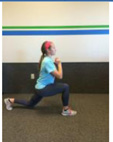 |
| 2. Walking Lunges | Start with reverse lunges. Place weight in rear to keep shank upright. Step into next lunge without intermediate step (one foot should always be in front of the other). Use skills and technique developed in reverse lunging to keep knee from excessive TPA even when moving forward. | Inhibit excessive tibial progression angle when moving forward. | "Transfer bodyweight to back heel when moving backward" | 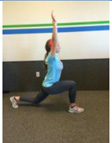 |
| 3. Wall Squat | Perform body weight squats with barrier (i.e. wall) at limit of tibial progression angle. Knees should not forcefully press against barrier at apex of depth. | Physical cue to prevent excessive tibial progression angle. | "Reach bottom away from heels" | 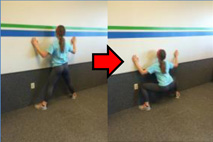 |
| STRENGTH/ STABILITY | ||||
| DEFICIT: Lack of strength of posterior chain to keep knee from translating excessively over toes. Excessive tibial progression angle can be a result of weakness in calf and soleus, weak hamstrings, weak gluteus or excessive quadriceps dominance relative to the hamstrings. | ||||
| TARGETED CORRECTION: Improve posterior chain strength, especially calves, hamstrings and gluteus maximus. | ||||
| Exercise | Description | Purpose | Cue | Example |
| 1. Step Up | Find a box or step approximately 1 ft. of the ground. Step onto box with one foot and use that foot to press other foot to the box. Step down first with second foot on the box. 10 reps. Repeat with other foot as the lead. Can use resistance to increase intensity. | Ensure knee on step tracks in line with foot and without excessive tibial progression angle. | "Straight shin on ascent" | 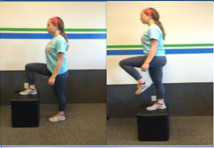 |
| 2. Heel Touches | Stand on a step or box approximately 1 ft. off of the ground. Have one leg hang off of the side. Perform single leg squat with opposite leg moving towards the ground. It is important to keep the pelvis even throughout the movement. Just before contact of the foot with the ground, use the foot on the step to press back up. | Ensure knee on box is without excessive tibial progression angle and functions as a unilateral leg strengthening exercise to promote side to side strength symmetry. | "Press on box to ascend" | 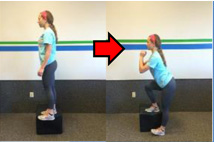 |
| 3. 1 and 1/4 Squat | Squat down for a 5-second count until thighs are parallel to the ground. Come up a quarter of the way at a slow and deliberate pace then descend back to parallel. Ascend to starting position. | To ensure recruitment and strengthening of the vastus medialis oblique at the bottom of a squat. | "Slow and controlled speed" | 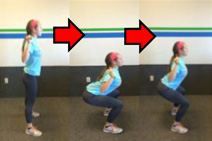 |
| MOBILITY | ||||
| DEFICIT: May not have adequate mobility of knee in sagittal plane. Lack of mobility of soleus and gastrocnemius. | ||||
| TARGETED CORRECTION: Ensure adequate mobility of knee in sagittal plane by improving mobility of calf and quadriceps. | ||||
| Exercise | Description | Purpose | Cue | Example |
| 1. Toe Touches | Stand upright. Reach down for toes. Stretch posterior chain. | Improve mobility of knee and hip musculature. | "Reach for toes" | 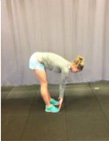 |
| 2. Straight Leg March | Walk forward with straight leg and opposite arm forward reach. Alternate sides on each step. | Improve mobility of knee and hip musculature. | "Bring toes to straight arm" | 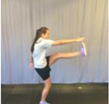 |
| 3. Leg Kicks: Forward and Backward | Stand upright and swing one leg forward and backward. Athlete may need a support to balance during this exercise. | Improve hamstring and gluteal mobility. | "Swing toes to eye level" | 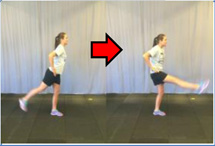 |
